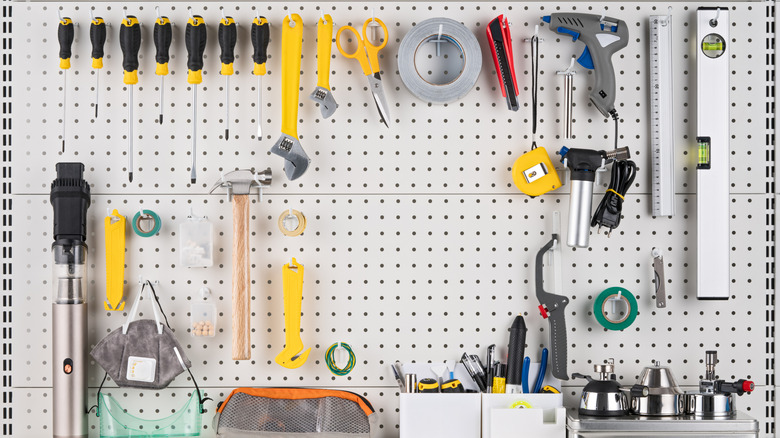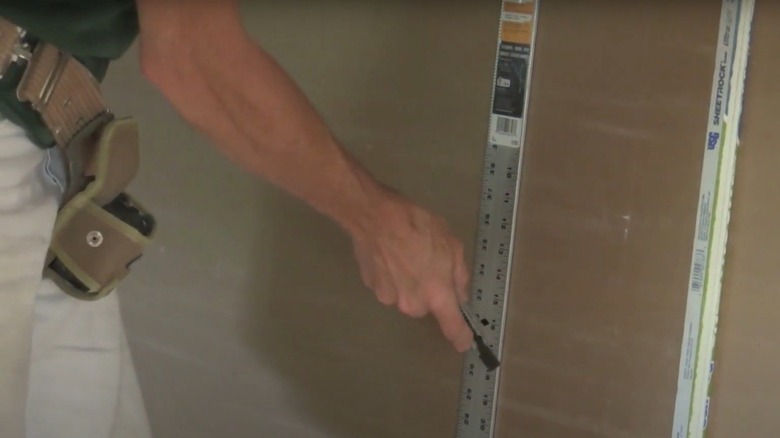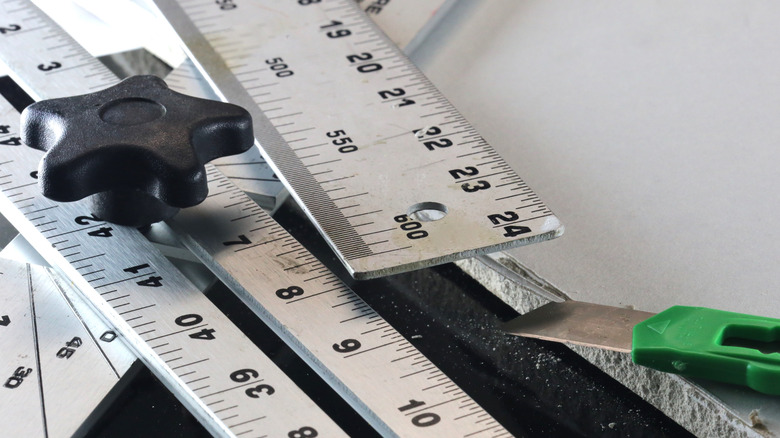The Handy Tool That Will Make Your Next Drywall Project A Breeze
We may receive a commission on purchases made from links.
If you want to learn how to hang drywall like a pro, it takes a mixture of practice, skill, and the right tools. Turning your next drywalling project into a DIY job could potentially cut the cost for the project in half compared to hiring a pro. However, you will have to spend some money purchasing the most essential drywalling tools, such as knives, a saw, a drill, and safety gear. Trying to use makeshift tools is a common mistake to avoid when installing drywall.
Another key tool that some professionals may try to skip but that is incredibly handy when you have to make a lot of cuts is a drywall T-square. Some professionals consider the drywall T-square to be a non-negotiable tool, while others just use a chalk line and cut the drywall with a utility knife by hand. When you have a T-square made from high-quality materials, though, it's a tool that can help you make highly accurate cuts.
The design of the drywall T-square resembles a "T." The longer blade section usually has a 48-inch length, designed to match the width of a typical sheet of drywall. Where it attaches to the longer blade, the shorter head section is offset, allowing you to place the head against the edge of the sheet while the blade remains flat to the sheet for easier cutting. Additionally, it includes measurement marks on both edges and sides, making it easier to make quick measurements, no matter how you have the tool aligned.
How to use a drywall T-square for your project
To cut down on the work required to mud and tape your drywall in a DIY project, making clean cuts is helpful. It's difficult enough to put mud on joints, so when you have poorly cut edges that butt up against each other, you'll have to take extra time to mud them properly. Additionally, when you make poor cuts in the drywall, you can end up with ragged edges that are more susceptible to breakage under stress. The T-square makes it easier to make straight, sharp cuts.
To use the drywall T-square, start by using a tape measure to determine the correct location to make the cut. Mark the cutting line with a pencil. Place the head of the T-square along the long edge of the sheet. The blade should be flat against the surface of the paper coating. Align the blade on the pencil marks for the cut line. Many people like to use the T-square's straight edge to draw the cut line with a pencil before cutting, just to provide a visual guide.
While holding the T-square firmly in place, use the blade to guide the utility knife and make a straight cut across the entire width of the sheet. Avoid tipping the knife blade, or the T-square might slide out of place, leaving you with crooked cuts. You only need to score the paper layer and a little of the depth of the material. Flip the sheet over and snap it back along the cut line. Then freehand cut through the remaining paper layer on the other side.
How to find a high-quality drywall T-square
You'll want a high-quality drywall T-square to ensure the straightest cuts. When choosing the materials, look for a tool that measures at least 3/16ths of an inch in thickness to yield the most stability. Material that's thinner will have more flexibility than you want when trying to make straight cuts. Thicker aluminum gives you the most stability in the tool to stand up to the pressure of the knife blade. For a standard 3/16-inch thick drywall T-square, like the Swanson TD124 model, you'll pay about $39, at the time of writing.
Although a few of these tools are made from wood or plastic, the majority of drywall T-squares will consist of aluminum. It's lightweight and durable, which is important because you might be using it in tough conditions. You'll want aluminum with an anodized coating in the construction. This ensures it will resist rust. Inspect the rivets between the blade and head sections. You want the two sections to be tightly connected, ensuring the tool won't come out of square if you drop it or apply pressure to it.
You could also purchase an adjustable drywall square, such as the Swanson AD124 model ($59). With the adjustable head, you can make angled cuts or shorten the length of the blade for cuts on non-standard sizes of drywall sheets. After you adjust the position of the head section, you'll lock it in place with a nut to create the necessary stability. The head section can turn 90 degrees to rest parallel against the blade for easier storage.


